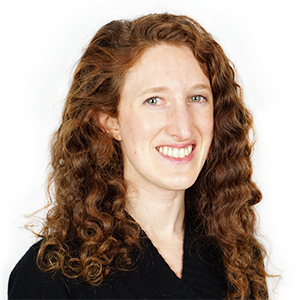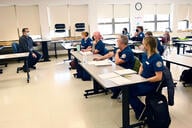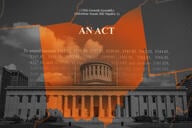You have /5 articles left.
Sign up for a free account or log in.
Trinity Church Wall Street
Roy Rochlin/Contributor/Getty Images Entertainment
Trinity Church Wall Street is located about a mile away from Borough of Manhattan Community College, but the two institutions seem worlds apart. The church is more than 300 years old and uncharacteristically wealthy; it held more than $6 billion in real estate assets in 2020. The college, one of seven community colleges in the City University of New York system, was founded 57 years ago and serves some of the city’s poorest students.
Almost half of BMCC students, 47.8 percent, received Pell Grants, federal financial aid for low-income students, in spring 2021. The student body is among the bottom 2 percent for community colleges nationwide in terms of socioeconomic status, according to data from the Equality of Opportunity Project.
BMCC, like most community colleges, has no dorms and enrolls many students who lack stable housing. A 2019 report by the Hope Center for College, Community, and Justice at Temple University found that 48 percent of CUNY students experienced food insecurity a month prior to taking the survey. More than half, 55 percent, said they were housing insecure, and 14 percent said they had experienced homelessness over the last year.
Beatriz de la Torre, managing director for housing and homelessness at Trinity Church Wall Street, said she was shocked when she read the report and wanted to help. The church plans to give the college $2 million to house up to 50 homeless students for three years and offer them a dorm-like experience. The grant is part of a record $46 million in donations to charitable causes doled out in 2021.
“To think about how that would feel, to try to get your degree while either sleeping in a shelter or really not knowing where you’re going to sleep tomorrow—and how awful that is and destabilizing—it just quickly crushed me,” she said. “I was just like, ‘We need to do something about this.’”
BMCC administrators are scoping out possible locations near the campus in lower Manhattan, and the housing could be available to a subset of students as early as this spring, with plans to ramp up to the full 50 students by this fall, according to de la Torre. She said BMCC will decide which students are eligible and which on-site services and amenities to offer.
BMCC officials said there are some housing options available to unhoused students but not nearly enough to meet demand.
The college’s Advocacy Resource Center works with community organizations to find emergency shelter for students and gives them emergency funds to help pay for housing. The center received more than 4,000 applications for emergency funding during the pandemic, most of which included requests to help pay rent, according to Karen Wilson-Stevenson, interim vice president for institutional advancement, and Julie Appel, director of Project Impact, a program for formerly incarcerated students at BMCC.
“Many of our students are housing insecure and live in shelters, couch surf, live in transitional housing or sleep on the subways,” Wilson-Stevenson said in an email. “It is very difficult to concentrate on academics while simultaneously worrying about where you are going to sleep at night.”
Nicholas Freudenberg, director of the CUNY Urban Food Policy Institute and a distinguished professor of public health, said CUNY community colleges primarily serve populations that are the “most vulnerable to housing instability and housing problems.” Three-quarters of CUNY community college students have family household incomes of $30,000 or less, which is far below the median household income in the New York City, according to a 2021 report by the Center for an Urban Future.
“As the largest urban public university, we have a high concentration of low-income students, students of color, immigrant students,” he said. He also noted that New York City struggles with “a particularly acute shortage of affordable housing.”
BMCC is a minority-serving institution with a student body that in fall 2020 was 39 percent Latinx and 32 percent Black—two groups that were hit hard by the economic fallout of the pandemic. The student housing problem was also exacerbated by the pandemic. Researchers at CUNY surveyed 528 students in April 2020, and then again a year later, to assess how the virus had affected students’ basic needs. In 2020, 9 percent of the students reported they were paying more for rent than before the pandemic, and 7.7 percent had moved due to the pandemic. Almost half of students said they were at least somewhat worried about losing their housing in 2020, and 38.8 percent said the same in 2021.
Freudenberg said while those percentages might sound “modest,” as a portion of the more than 250,000 students enrolled at CUNY institutions, the impact is “substantial.”
“There was a lot of housing disruption as a result of the pandemic,” he said. “Some people could no longer afford where they were staying, so they moved in with family or friends, and other people had to pay more of their income for housing. And what we’ve learned both at CUNY and in New York is when you pay more for housing, you have less for everything else.”
Those conditions can hinder students’ academic progress and have contributed to pandemic-related enrollment declines at CUNY campuses and colleges nationwide, he added.
“If you’re worried about losing your housing, that makes it much harder to focus on schoolwork,” Freudenberg said. “It makes you think about having to go out and get a job; it makes you wonder about whether you can afford to pay tuition or the expenses related to college textbooks and so on.”
Ann Shalof, CEO of the Neighborhood Coalition for Shelter, which provides supportive housing to unhoused young adults and those transitioning out of the foster care system, said there are likely academic advantages to homeless students living together. The coalition received a planning grant from Trinity Church last year to develop a similar pilot program to house up to 50 CUNY students and provide them with support services. The goal is to ultimately create a model that can be studied and replicated, though the project is still in the planning stages.
The hope is to offer a “learning environment,” she said. “If you think of a college dorm, the idea for us is that there would be a cohort that would be living and learning in the way that many people do when they go to college. I think also you’re going to have a range of need among the students. For example, you may have some that say, ‘Thanks for the roof over my head. I don’t really need anything else,’ and you may have some who have all of the trauma and needs that come from whatever they’ve experienced up to that point in their lives. We would be prepared to serve the whole spectrum.”
Christina Endres, program specialist at the National Center for Homeless Education, said it’s more common to see colleges address student homelessness by working with individual students rather than providing a housing option specifically designated for unhoused students, though she’s heard of some similar efforts at other colleges and universities.
She believes college leaders nationwide have a growing awareness about the needs of unhoused students.
“For as long as there have been colleges, there have been students who have struggled with that,” she said. “Colleges are recognizing that this is an issue and they do need to have some supports in place for students.”
de la Torre stressed that student homelessness is a problem “way too big for philanthropy to solve.” While partnerships like Trinity Church’s with BMCC can help, she said policy makers still need to come up with broader solutions.
Freudenberg agrees. He believes New York lawmakers should make concerted efforts to expand the pool of affordable housing for students and other low-income city residents.
“It should not be that in the richest city in the world, any college student should be living in the streets,” he said. “To allow them to be homeless and to jeopardize their success in school is poor, shortsighted, penny-wise, pound-foolish policy.”
Shalof noted that young adults can be overlooked as a significant unhoused population because they remain “largely hidden.” They’re less likely to show up at homeless shelters and “will couch surf” or “they will go from relative to relative. They might spend their nights in arcades … find an all-night McDonalds to sit in” to avoid the dangers and discomforts of shelters, she said. They’re often physically able to sleep on a floor or couch instead, which means “they may not be counted among people who are homeless, but they nevertheless are. We need to be aware that this population of kind of invisible homelessness exists.”
As de la Torre awaits broader, more long-term solutions from policy makers, she wants other philanthropic organizations to “adopt” their local community colleges.
“My hope is that this is scaled,” she said. “I understand that this is a small contribution to address an enormous issue. I hope it brings attention to this really troubling issue that exists in New York City but also beyond.”





